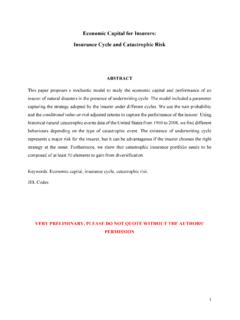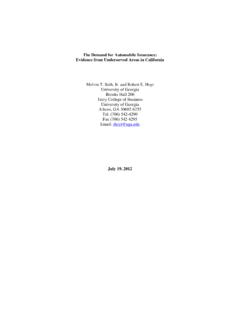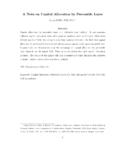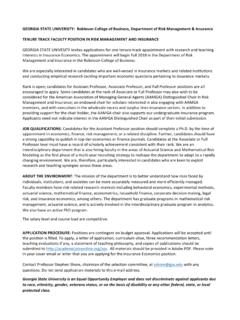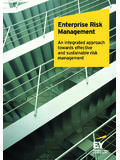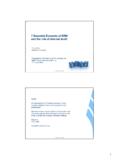Transcription of ERM Determinants, Use, and Effects on the Firm
1 ERM Determinants, Use, and Effects on the Firm David M. Pooser Assistant Professor of Risk Management and Insurance School of Risk Management Peter J. Tobin College of Business St. John s University Kathleen A. McCullough State Farm Insurance Professor in Risk Management and Insurance Department of Risk Management & Insurance, Real Estate, and Legal Studies College of Business Florida State University Communications: Author: David M. Pooser Phone: 850-508-7344 Email: 1 ERM Determinants, Use, and Effects on the Firm ABSTRACT Enterprise risk management (ERM) is being implemented more frequently by insurance firms, and regulators and ratings agencies are placing greater emphasis on the effectiveness of firm risk management. This paper uses ERM rating data from Standard and Poor s Ratings Direct combined with the NAIC property and casualty insurance annual statements to identify insurers that do and do not obtain ERM program ratings.
2 We examine which firm characteristics are associated with obtaining an ERM rating, test if ERM rated firms jointly manage firm risk using multiple risk management techniques, and test if ERM rated firms are more resilient to shocks than non rated firms. We find that several firm characteristics are significantly related to an ERM rating, including larger and publicly traded firms. We find that the risk management techniques of ERM rated firms are jointly significant in explaining firm risk, while there is no finding of joint significance for non-ERM rated firms. This underscores the tenant that insurers with ERM programs use a variety of techniques to jointly manage firm risk. Finally, we find that firms with an ERM rating experience on average fewer shocks and better performance in the variables that underlie shocks than non-ERM rated firms. The results from this study are important to firm stakeholders, regulators, and ratings agencies that seek to measure the risk management behavior of firms with and without ERM.
3 SECTION I INTRODUCTION Risk management for corporations has been practiced since the 1960 s. It evolved from the treatment of insurable risks to more complex financial and operational risk management methods. Many corporations, however, viewed the risk management process as a function of second order importance and treated individual risks in a silo approach where each risk was considered to be independent of others and was managed in a way to minimize the firm s exposure to the risk. A process that has started to receive industry and academic notice is enterprise risk management (ERM). Generally speaking, ERM is the simultaneous measurement and management of all categories of firm risk in different states of nature ( a good economy or bad economy). Because ERM is such a broad concept, clearly defining the process is difficult. The Casualty 2 Actuarial Society in their Overview of Risk Management (2003) defines ERM as.
4 The discipline by which an organization in any industry assesses, controls, exploits, finances, and monitors risks from all sources for the purpose of increasing the organization s short- and long-term value to its stakeholders .1 Regardless of definition, at its most basic level, the purpose of ERM is to create value for a firm s shareholders. Firms have historically performed risk management by attempting to minimize the cost of firm risk through transfer, reduction, retention or avoidance of risk exposures. Traditional risk management and financial risk management typically separated the management of loss exposures using separate contracts and retentions for these risks (Dickinson, 2001). In an ERM framework, however, firm risks are considered as a portfolio, and total firm risk is not the sum of its individual risks (Kleffner, Lee and McGannon, 2003), due to negative or non-correlation between risk exposures.
5 Part of the difference between traditional risk management and ERM is the treatment of pure, speculative, transferable and nontransferable risks simultaneously (Dickinson, 2001). Now, especially after the financial crises of the past decade, risk management has shifted from what was often a minor consideration for firms, handled by the treasurer, comptroller, or an insurance risk manager, to a very high-profile activity, overseen by the CFO, or in some cases, a CRO (chief risk officer). Previous research on ERM typically focused on the determinants of ERM implementation, the Effects of an ERM program on firm value, or some other link between ERM and financial performance. This paper extends the empirical literature on ERM by testing the characteristics of firms obtaining an ERM program rating through Standard and Poor s Ratings 1 Other sources define or describe ERM as dealing with uncertainty for the organization, (Monahan, 2008); a method of dealing with financial, insurable, operational, and business risk that views all risks as being able to upset firm stability, and in which risks cannot be isolated, but are affected by firm exposure to other risks (Doherty, 2000); and a number of other definitions that involve treating all firm risk exposures simultaneously ( , D Arcy, 2001; Kleffner, Lee and McGannon, 2003; Gates, 2006).
6 3 Direct. We also test for potential differences in the behavior of firms with and without ERM ratings. To do this, we propose three hypotheses. First, we test whether firms with ERM ratings are systematically different from firms without ERM ratings. Second, we test whether the ERM rated firms differ in their use of risk management techniques from non-ERM firms. Finally, we exam whether the presence of a rated ERM program makes the firm more insulated or resilient to shocks to firm performance and to changes in firm performance. Together the results provide insight into the use of rated ERM programs as well as the behavior of those firms. This approach has several advantages. First, Hoyt and Liebenberg (2011) state that, One of the major challenges facing researchers is how to identify firms that engage in ERM . Many prior empirical analyses have employed survey data of firm ERM practices reported through questionnaires ( , Kleffner, et al.)
7 , 2003) or press releases and news articles ( , Liebenberg and Hoyt, 2003). This paper uses Standard and Poor s Insurer ERM Ratings Direct data to identify insurers with ERM programs and compares ERM rated firms to those insurers that do not obtain ERM ratings. The use of Standard and Poor s Insurer ERM ratings means that the tests should be less sensitive to sample bias due to missing survey responses or ambiguity in coding news Further, unlike some studies, the sample includes the entire population of property and casualty firms rather than just publicly traded firms or survey we also employ a simultaneous equations methodology to model firm risk and risk management technique By modeling the system or risk management techniques and firm risk simultaneously, we are able to test whether there is a stronger interrelation in the use of 2 It is important to note that studies that have used survey responses and news searches to analyze ERM have provided an extremely rich and valuable framework for future tests on ERM.
8 And that this research seeks to further explore and clarify insurer ERM behavior and not to belittle or ignore the importance of these prior studies. 3 Several prior ERM studies rely on smaller samples due to limited survey responses or available information. For example, Kleffner, et al. (2003), Liebenberg and Hoyt (2003), and Hoyt and Liebenberg (2011). 4 In an ERM framework, all risk management techniques are considered simultaneously, and the interrelation between the risk management techniques is important to an insurer making its risk allocation decisions. 4 risk management techniques with ERM ratings as opposed to those without. The potential interrelation in the ERM rated firms and lack of interrelation in the non-ERM rated firms would provide empirical evidence of differing behavior that would validate the presence of an ERM program through the firm s behavior. Finally, we test whether or not firms with ERM ratings experience fewer performance shocks than firms without ERM ratings and if these firms experience more favorable performance in the factors underlying shocks.
9 These tests allow me to observe whether or not ERM is effective in insulating the firm from negative performance shocks or adverse events. Preventing or reducing the impact from an adverse event is a valuable contribution from an ERM program. We consider shocks to ROA, loss ratio, net income, and policyholder surplus. we also examine the change in the loss ratio based on the presence of an ERM program rating. Our empirical findings support the hypotheses. Related to the first hypothesis, ERM rated firms are significantly different from non-ERM rated firms, with findings mostly consistent with prior literature. For the second hypothesis, we find evidence that firms with ERM ratings manage firm risk using simultaneous risk management techniques, while we do not find evidence of this for non-ERM rated firms. For the third hypothesis, we find that ERM rated firms typically experience fewer average performance shocks than non-ERM rated firms.
10 We also find that ERM rated firms experience fewer adverse changes (and experience more beneficial changes) in the performance variables underlying shocks than non-ERM rated firms. This provides evidence that ERM programs help to insulate these firms from adverse events. This research has important implications for future empirical research on ERM as well as for regulators and ratings agencies examining ERM for insurers or other financial firms. we directly compare insurers that obtain ERM ratings and those that do not for the entire 5 property and casualty insurance industry, providing insight into the firm characteristics that differ between these groups. As requirements related to the utilization of ERM increase, this will help regulators and firms tasked with measuring ERM behavior to understand which firms are likely the early adopters of obtaining the ratings. The paper models the interrelation of risk management techniques with firm risk in order to determine whether or not ERM rated firms are more likely to jointly manage risk, which helps answer whether or not ERM does lead to significant interrelation in a firm s risk management techniques.



